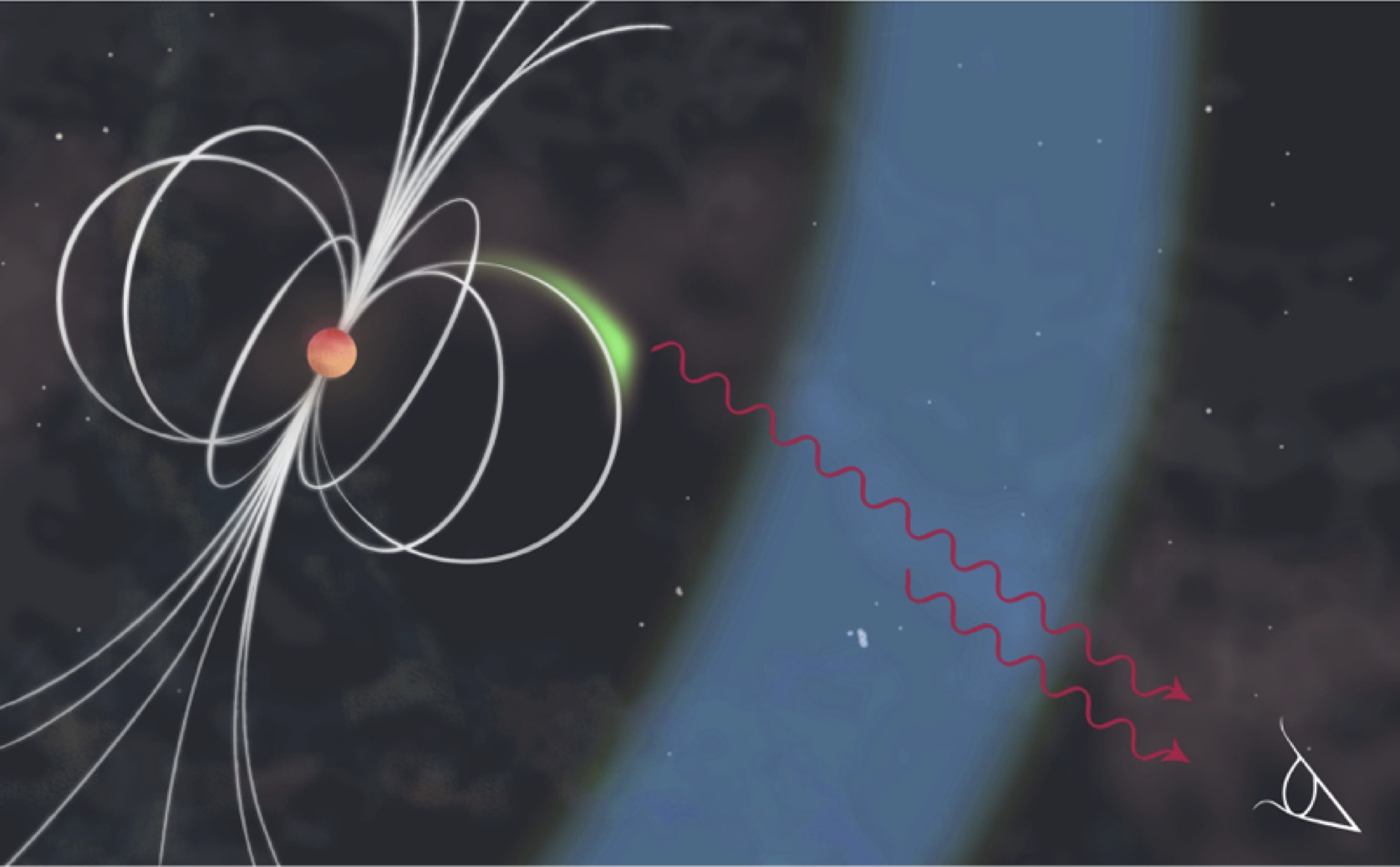The most energetic light ever observed from a pulsar

The neutron star (red circle) with its strong magnetic field (white lines) spins around itself nearly 30 times per second injecting energetic electrons in the region of the Galaxy around it. The green and blue shaded regions depict different particle acceleration zones from where the detected photons could originate. The green zone lies in the vicinity of the pulsar's magnetosphere, whereas the blue zone could be as far as 100 000 km away from the pulsar.Credits: Patricia Carcelén Marco
The neutron star (red circle) with its strong magnetic field (white lines) spins around itself nearly 30 times per second injecting energetic electrons in the region of the Galaxy around it. The green and blue shaded regions depict different particle acceleration zones from where the detected photons could originate. The green zone lies in the vicinity of the pulsar’s magnetosphere, whereas the blue zone could be as far as 100 000 km away from the pulsar.
Credits: Patricia Carcelén Marco
Energies a thousand times larger than the previously observed
The Crab pulsar is a tiny neutron star, of about 10 km in diameter, which rotates 30 times per second. It behaves like a huge magnet creating extremely large magnetic and electric fields around it. And it creates a beam of light that we receive every time the rotating beam crosses our light of sight, similar to what a lighthouse does, but with energies in order of magnitude larger than the normal light we see. This radiation reaches us with energies comparable to the ones created in i.e. the large hadronic accelerator in the CERN.
In 2011, an unexpected tail of energetic photons was discovered by the telescopes MAGIC and Veritas. To understand this phenomenon, the MAGIC team performed deep observations of the Crab pulsar, expecting to measure the maximum energy of the pulsating photons. The new observations detected photons with energies a thousand times (x1000) larger than the previously observed. The photons, with energies of more than trillion electron volts (~TeV = 1e12 eV), arrive to the detector every 33 milliseconds, bringing information of the close proximity of the neutron star. Those photons should be the product of electrons and positrons being burnt out in the surrounding of the neutron star, due to the large magnetic field, after being accelerated to relativistic velocities. But how and where this effect is achieved in such a small region challenges our knowledge of physics.
“We performed deep observation of the Crab pulsar with MAGIC to understand this phenomenon, expecting to measure the maximum energy of the pulsating photons”, says Emma de Oña Wilhelmi from the Institute of Space Sciences (IEEC-CSIC) and Principal Investigator of this observation program says. Roberta Zanin from the Institute of Cosmos Sciences (IEEC-UB) continues: “The new observations extend this tail to much higher energies, above TeV energies, that is, a hundred times more energetic than the previous measurement, violating all the mechanisms believed to be at work in neutron stars.”
Where and how this TeV emission is created remains still unknown and difficult to reconcile with the standard plasma theories.
MAGIC observatory
MAGIC is a ground-based gamma-ray observatory located on the Canary island of La Palma, Spain. The system of two 17m diameter Cherenkov telescopes is currently one of the three major imaging atmospheric Cherenkov instruments in the world. It is designed to detect gamma rays between tens of Giga-electron-volts (109 eV) and few tens of Tera-electron-volts. MAGIC obtained data from the Crab pulsar during more than 300 hours, and the team analyzed a large set of data obtained between October 2007 and April 2014.
The data and results have been analyzed by a research group led by Emma de Oña Wilhelmi and Diego Torres from the Institute of Space Sciences (IEEC-CSIC), Roberta Zanin and Daniel Galindo Fernandez, both from the Institute of Cosmos Sciences (IEEC-UB) and David Carreto Fidalgo from the Complutense University of Madrid (UCM).
The Crab, the most powerful pulsar in our galaxy
Pulsars are rapidly rotating highly magnetized neutron stars. Weighing more than our Sun, yet only several km in radius, these extremely dense objects are embedded in a magnetic field with strengths as high as 10 8−15 G at the surface of the star. This high magnetic field, together with the fast rotation of the star with periods of a few milliseconds, produces beams of electromagnetic radiation, which sweep the sky like a lighthouse.
In particular, the Crab pulsar, created in a supernova explosion that occurred in 1054 AD, is located at a distance of about 6500 light years at the center of a magnetized nebula visible in the Taurus constellation. The Crab is the most powerful pulsar in our galaxy and it is one of the few pulsars detected across all wavelengths, from radio up to gamma rays. In its magnetosphere (or magnetized atmosphere) of only a few thousand kilometers, electrons and positrons are accelerated up to relativistic energies but they are quickly burned in the high magnetic field, emitting radiation that arrives to our telescopes in the form of pulses every 33 millisecond, once for each time the neutron star rotates and meets our telescopic sight. This radiation stops abruptly when the fastest electrons are burnt (that is at ~1GeV=109 eV) below the energy range Cherenkov telescopes can observe. But the new observations with MAGIC unveiled a mysterious, faint but extremely energetic radiation (thousand times larger) beyond this abrupt cutoff which are yet of unknown origin.
